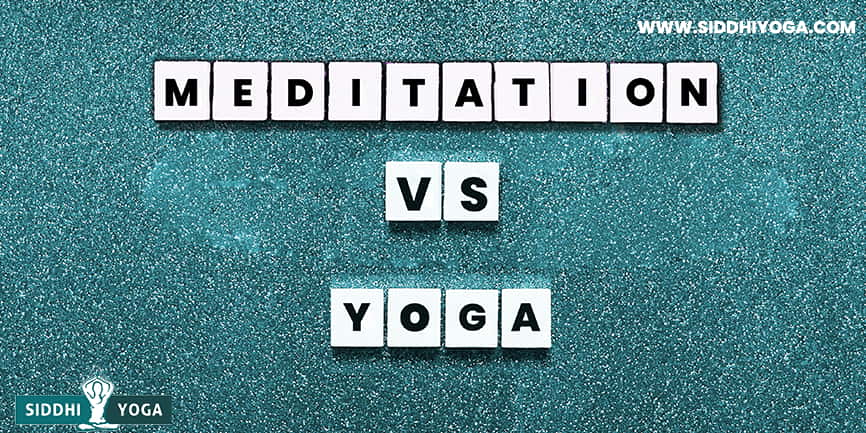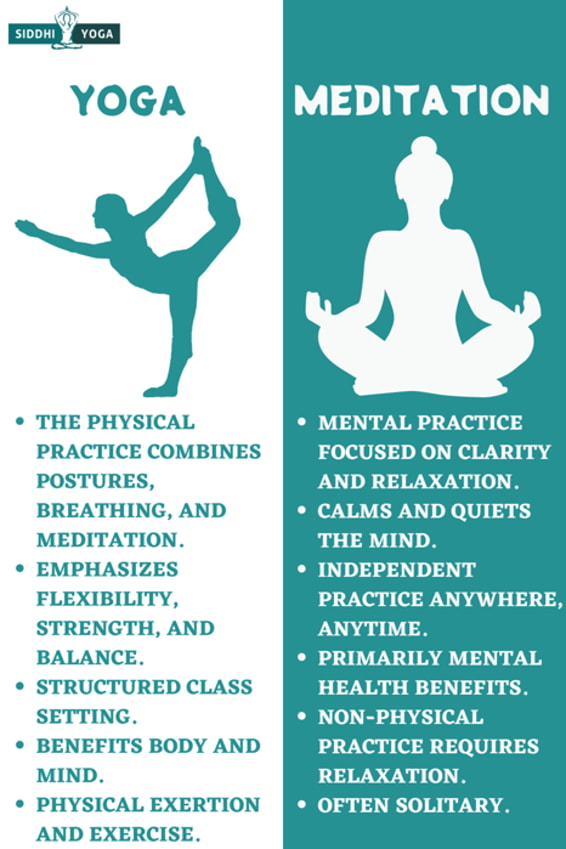
Are you wondering if you’re practicing meditation or Yoga? Or both? This article, ‘Meditation vs Yoga’- uncovered similarities & differences in these terms.
Introduction
Today, Yoga has become a global phenomenon. You see pictures of people practicing it in magazines, social media, TV ads, your neighborhood gym, and even your office. But are these people practicing Yoga or meditation? Or both?
For some people, Yoga is just the Asanas. If that’s the case, even if you are doing a downward dog a day, you can claim to be a yogi – that is, someone who practices Yoga.
To others, Yoga is all about sitting still for hours and listening to your breath. In this case, you are practicing Yoga even if you are meditating. Is that true?
So, which group of people is correct?
Is All Yoga Meditation?
The people I described above are not wrong but are not correct. Yoga is not just Asanas (poses) and not just meditation either. Yoga is not even the two combined.
Yoga is not all meditation. Some styles of Yoga focus on meditation, while others focus on the other “limbs” of Yoga, such as Asana or Pranayama. Let’s explore these limbs below.

Yoga as an Eight-Fold Path
In the Yoga Sutras of Patanjali, the most popular book on the theory and practice of Yoga, Yoga is an eight-fold path. It is known as the Eight Limbs of Yoga or Astanga Yoga System. They are:
Yamas
Yamas are ethical rules in Yoga that you must follow to live your life with integrity. Generally, they are the standards of how you should treat others. These include:
Ahimsa: Non-violence. You should also practice non-violence towards yourself and all other beings in the world.
Satya: Truthfulness. You should speak only the truth in every circumstance.
Asteya: Non-Stealing. You should never take anything that does not belong to you.
Brahmacharya: Continence. You should always use energy properly, which means controlling or moderating it.
Aparigraha: Non-Covetousness. You should not be greedy or overly attached to things.
Niyamas
Niyamas are the ethical standards you have to live by and the habits you should cultivate following the eight-fold path. They are:
Saucha: Cleanliness. You should be clean in the physical sense and regarding the environment and your thoughts and habits.
Santosha: Contentment. You should be content and accept yourself for what you are and what you have right now.
Tapas: Discipline. Yoga is a journey. Therefore, you need to cultivate the discipline to continue on your journey toward enlightenment.
Svadhyaya: Self-study. You should continue on your path to self-awareness.
Isvara Pranidhana: Surrendering to a Higher Power: You should cultivate your faith and surrender to God or whatever higher power you believe in.
Asanas
Asana is the physical aspect of Yoga. The Sanskrit word translates to “seat” or “seated posture.” Asanas in Yoga are necessary to keep the body strong and supple to prepare it for meditation. Traditionally, Hindu monks would practice their Asanas while sitting. Today, many Asanas exist, including standing Asanas, inversions, backbends, etc.
Pranayama
Pranayama comes from the Sanskrit words Prana, which means “life force,” Ayama, “expansion,” and Yama, “control.” It is the expansion or control of the breath. In Yoga, the focus is on the breath. You control or expand it depending on what your intention is.
Pratyahara
Pratyahara comes from the Sanskrit words prati, which means “against” or “contra,” and ahara, which means “bring.” It is withdrawing your senses from the outside world and turning them inward. This is the starting point of meditation in Yoga.
Dharana
Dharana is the Sanskrit term for “concentration” or “one-pointedness.” After withdrawing your senses from external objects, you bring awareness to one mental object. This object could be a mantra, a deity, a chakra, or an intention.
Dyana
Dyana means “meditation” or “contemplation.” It may sound the same as Dharana, but it is different. In Dharana, you focus on one point. In Dyana, your mind is quiet and still. You are aware and focused on one point, yet you are not trying and not giving meaning. You see this one point.
Samadhi
In the Yoga Sutras of Patanjali, Patanjali describes Samadhi as the state of ecstasy where you are united with the Divine or the universe.
Takeaway
Yoga, in its proper form based on the Yoga Sutras of Patanjali, is an eight-fold path. So, all Yoga is meditation, but meditation is just one aspect. Not all types of yoga practice meditation, though. Some focus more on Asanas or the other limbs, while others focus on meditation. You cannot call these practices Yoga if they don’t practice the other limbs.
Is All Meditation Yoga?
As mentioned above, meditation is just a part of Yoga. So, you may ask, “does this mean that all meditations are considered yoga?” The short answer is no.
There are many types of meditation. Most of these meditations are connected to religion, particularly Hinduism and Buddhism. The first meditation practitioners were Hindu monks. Kundalini, Bhakti, Raja, Jnana and other meditations from India all stem from Hindu beliefs. Later, other types of meditation were developed that were not linked with Hindu beliefs.
Today, many mainstream religions have developed their meditation traditions and rituals. For example, Zen meditation, which is a Buddhist practice. Daoism has its meditation practice that involves cultivating the Qi, which is the same as Prana in Yoga. Christianity, Islam, Judaism, and other religions have also developed meditation practices.
Takeaway:
Yoga is a journey. But it is a journey that you can never complete. Why is that so? It’s because there is always something new about yourself to be discovered. If you don’t practice meditation, technically, you are not practicing Yoga. As mentioned above, Yoga has eight limbs. Meditation is just one of them. However, practicing just this one limb of Yoga is a great start. Some people call the practicing of yoga postures “moving meditation.” You remain in the present moment, even while moving your body. That can still be considered “meditation.”
For most people, Yoga is just practicing the Asanas and focusing on the breath. These two limbs are an excellent start to your yoga journey. As you continue your practice, you will reap the benefits and maybe feel inclined to deepen your knowledge of Yoga. It usually happens when people start doing yoga poses and breathing exercises
Some common mistakes In Meditation vs Yoga
As you start your yoga and meditation journey, you may wonder if you are doing it correctly. Here are some common mistakes people make, which you need to look out for so you’ll know how to handle them:
You Should Blank Out Your Mind
False! In meditation practice, you should never expect to be able to blank out all thoughts – in other words, to be thoughtless. The mind doesn’t work that way. Thoughts will constantly be flashing across your mind. And that is fine. Ironically, the more you push yourself not to think. The more thoughts will stream into your mind. Let’s be clear: Meditation is not about emptying your mind of thoughts; it is about directing your mind to a point or just one thought. Usually, it is your breath.
You Judge Yourself
Another common mistake while practicing Yoga and meditation is judging yourself. Don’t be harsh on yourself, and judge yourself, when you find that you cannot do certain yoga poses, cannot meditate for one hour straight, or can’t even stay still for a minute. You are a precious soul. Even if you cannot do certain things, others can. You are still worthy of acceptance. Accept yourself for who you are at the present moment. What matters most in Yoga is that you continue to practice.
Focussing too much on the Shape
When practicing yoga Asanas, don’t focus too much on the Shape. For example, when doing a Wheel Pose, the form of your teacher will not be the same as your form. We have different anatomies! Focus on your alignment instead. By doing this, you will lessen the risk of injury.
The Bottomline
Meditation does not equate to Yoga. Meditation is just a part of the larger Yoga. Furthermore, some types of meditation were not derived from any yoga tradition. But meditation – and meditation! – is an effective tool for self-awareness and a healthy lifestyle.
Do you need to ease your mind and improve your health? Start practicing meditation. Join our 30-day meditation challenge.